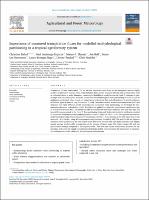| dc.contributor.author | Benegas-Negri, Laura | |
| dc.contributor.author | Birkel, Christian | |
| dc.date.accessioned | 2025-05-12T21:42:19Z | |
| dc.date.available | 2025-05-12T21:42:19Z | |
| dc.date.issued | 2023-12-23 | |
| dc.identifier.uri | https://repositorio.catie.ac.cr/handle/11554/12790 | |
| dc.description.abstract | Evaporation (E) and transpiration (Tr) are the key terrestrial water fluxes to the atmosphere and are highly sensitive to land cover change. These ecohydrological fluxes can be measured directly only at small scales, such as individual plants or under laboratory experiments. Modelling is needed to upscale E and Tr estimates to plot, hillslope and catchment scales. However, model-derived ecohydrological water partitioning of E and Tr can be ambiguous, particularly when models are trained using hydrometric data and soil moisture. To test the influence of different types of data (i.e., sap flux-derived Tr, Eddy Covariance-derived actual evapotranspiration (AET) and measured soil water (SW)) on model calibration and subsequent water partitioning, we developed the low-parameter plot scale ecohydrology model EcoHydroPlot applied to a data-rich experimental agroforestry plot in humid tropical Costa Rica. The model was able to simulate SW well when calibrated with any data type, but large differences emerged in the E and Tr flux partitioning. Using only hydrometric data for calibration resulted in parameter configurations that produced greater E over Tr fluxes (Tr/AET < 0.5). The opposite was seen for model calibration using Tr data (median Tr simulations with KGE > 0.6), resulting in Tr/AET ratios close to the observed ∼0.9. Further, using all measurements simultaneously (including AET, SW and Tr) did not improve simulated water partitioning. We only found small differences between sun and shade locations with slightly greater average shaded coffee transpiration at the expense of lower upper SW, higher deeper SW and less groundwater recharge compared to sun exposed coffee. This work can inform measurement priorities for applications with relatively simple conceptual ecohydrology models and emphasizes the importance of transpiration estimates for model calibration beyond tropical environments. | es_ES |
| dc.format.extent | 15 páginas | es_ES |
| dc.language.iso | en | es_ES |
| dc.publisher | Elsevier | es_ES |
| dc.relation.ispartof | Agricultural and Forest Meteorology | es_ES |
| dc.relation.uri | https://doi.org/10.1016/j.agrformet.2023.109870 | es_ES |
| dc.subject | Ecohydrology | es_ES |
| dc.subject | Water partitioning | es_ES |
| dc.subject | Conceptual modelling | es_ES |
| dc.subject | Transpiration | es_ES |
| dc.subject | Tropics | es_ES |
| dc.subject.other | Sede Central | es_ES |
| dc.title | Importance of measured transpiration fluxes for modelled ecohydrological partitioning in a tropical agroforestry system | es_ES |
| dc.type | Artículo | es_ES |
| dc.identifier.status | restrictedAccess | es_ES |
| dc.subject.sdg | ODS 6 - Agua limpia y saneamiento | es_ES |
| dc.subject.sdg | ODS 13 - Acción por el clima | es_ES |
| dc.subject.sdg | ODS 15 - Vida de ecosistemas terrestres | es_ES |


